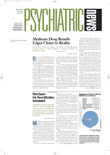Older women who take serotonin reuptake inhibitors or tricyclic antidepressants in combination with narcotics have a significantly elevated risk of sustaining a nonspinal fracture.
Previous research had indicated that, at least in the case of narcotics, the medications alter the patients' gait and steadiness, directly increasing the patients' risk of falling and, as such, indirectly increasing the rate of fractures sustained during those falls.
Now a new report suggests that for SSRIs and TCAs, the relationship may be more complicated. That report appeared in the April 28 issue of Archives of Internal Medicine.
"We know that antidepressants do increase the rate of falls in elderly women; we had confirmed that in an earlier study from our group," said Kristine Ensrud, M.D., a professor of medicine at the Minneapolis Veterans Affairs Medical Center and the University of Minnesota, and the lead author of the new report.
"But in this new study," Ensrud told Psychiatric News, "even controlling for the diagnosis of depression, controlling for depressive symptoms, and controlling for the patients' rate of fall over the prior 12 months, we see that rate of fall does not account for the increased rate of fractures. I think there's something else going on here."
Ensrud and her colleagues examined the use of four classes of CNS active medications -benzodiazepines, anticonvulsants, antidepressants, and narcotics-in more than 8,000 women who were at least 65 years of age. The women were interviewed to determine medication use, which was then verified through examining prescription- medication bottles during two periods: 1992 to 1994, and 1995 to 1996. Fractures were assessed through history and verified through radiographic reports.
Ensrud's team found that, during an average of 4.8 years of follow-up, 1,256 women (15 percent) had at least one nonspinal fracture, including 288 (4 percent) with a first hip fracture. Compared with women not taking any of the four classes of medications studied, women taking narcotics had almost a 40 percent increase in risk of a nonspinal fracture, and women taking an antidepressant were 25 percent more likely to experience a nonspinal fracture.
Of those women taking an antidepressant, fracture rates were not statistically significantly different between the women taking an SSRI and those taking a TCA. However, Ensrud's group had previously reported that rate of fall was higher in those taking an SSRI than in those taking a TCA.
"Even more important," Ensrud added, "women taking antidepressants were 70 percent more likely to have a hip fracture while taking the medication. Hip fractures are especially devastating and are often significantly debilitating over the long term."
Ensrud and her colleagues believe that the link between antidepressant use and increased incident fractures, especially the more serious hip fractures, is a more direct medication effect. Prior studies, she said, have linked clinical depression or depressive symptoms to lowered bone density. But other studies have not found this association, and in the current study cohort, Ensrud said, they did not see any significant difference in bone density in elderly women taking antidepressants. And even adjusting for any small difference that was present in bone density, there was no substantial difference in the association between medication use and fracture.
The current study also attempted to control for any "confounding by diagnosis," and "confounding by indication," Ensrud said. When the team analyzed the data, controlling for factors such as functional impairment, cognitive function, depressive symptoms, weight change, and neuromuscular performance, Ensrud added, "antidepressant use appeared to be a more robust predictor of fracture than other potentially confounding factors."
Obviously, she noted, "the association here is not simple, and we don't really know what the link is yet." But, she added, "In this particular case, some might have expected the risk of fracture to be higher with TCAs than SSRIs because of their side-effect profiles. We didn't find that. One sort of takehome lesson, then, is that we cannot simply assume that newer medications, such as SSRIs, are safer compared with older drugs, such as TCAs, simply because they are new."
Archives of Internal Medicine 2003 163 949
